Top meadow lawn mistakes – and how to avoid them
We’ve made a few meadow lawn mistakes.
We tried to create two mini meadow lawn patches. Last year, we stopped mowing two squares of meadow lawn in our front garden.
But we haven’t been happy with the results. I wanted a constantly changing sward of wild flowers, not an unkempt green area with green, floppy grass full of weeds.
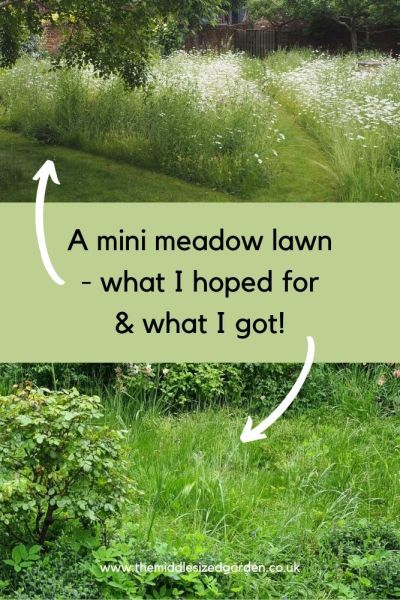
Mini meadow lawn mistakes? Or do I just need to give it time? I asked wildlife garden landscaper and expert, Joel Ashton.
So I asked advice from award-winning garden landscaper Joel Ashton, author of Wild Your Garden, whose company Hazelwood Landscapes designs and installs wildlife friendly gardens and larger landscapes.
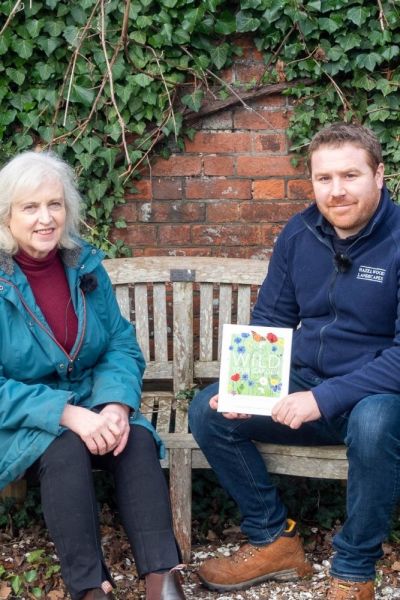
As well as being the author of Wild Your Garden, Joel Ashton has appeared frequently on TV (Gardeners World, Springwatch, The Steph Show and more), advising on wildlife friendly gardening.
Joel also has a YouTube channel called Wild Your Garden with Joel Ashton. His most famous video is a fascinating time lapse of digging a garden pond – a brilliant resource if you’re planning to make a small garden pond. He also covers how to make meadow lawns, along with every other aspect of wildlife in gardens and has interviewed experts such as David Attenborough, Chris Packham and Alan Titchmarsh.
Common meadow lawn mistakes – not thinking about the soil
Joel explains how to create a meadow lawn in Wild About Your Garden. To create a perennial meadow that will return every year, you need poor soil. But garden lawns are often on relatively rich, fertile soil.
So you may have to scrape off or strip out the most fertile soil. Then you can replant with meadow grasses and flowers. You can sow seed, use plug plants or buy a specialist meadow lawn turf. You’ll get a beautiful meadow lawn or mini meadow.
But there are different issues if you just stop mowing. We didn’t want to destroy a large colony of ground-nesting bees in our front lawn. So we just stopped mowing and added lots of wildflower seed. So far, none of it has come up.
Traditional lawn grasses are too vigorous
If you just stop mowing your patch of grass, it may not turn into a wildflower meadow immediately because lawn grasses are often too strong and well established, Joel explains.
That doesn’t mean you can’t turn it into a meadow lawn patch. But it will take time and you’ll have to help it. Perhaps one of the biggest meadow lawn mistakes is to expect that it will look like a meadow in its first or second year.
Yet those wildflowers are often still there, he says. ‘If you haven’t used fertiliser or weedkiller on your lawn for years, and if you have mown it regularly, removing the cuttings, you have ‘a meadow lawn desperate to grow.’
In this first year, our lawn grasses overwhelmed the seeds we’d sown. And they also suppressed the growth of any long dormant seeds that may be there.
However, I’ve got a number of friends who created perennial mini meadows by not mowing, so I know it can be done. I just needed to know what meadow lawn mistakes I was making.
Use 9cm plants for an instant effect
Joel suggests buying 9cm plug plants which are big enough to compete with the grasses, even in the first year of the meadow lawn. In his video on How to Make a Wildflower Meadow – Top Plants to Include, he recommends perennials such as Ox-eye daisies, Birdsfoot trefoil (Lotus corniculatus) and Black knapweed (Centaurea nigra).
His book, Wild Your Garden, has a useful section at the back with lists of plants for various types of meadows, soils and situations. I picked out cowslip, dark mullein (Verbascum nigrum) and Field scabious (Knautia arvensis) as plants that would suit our generally dry-ish weather.
Joel also recommends primroses, red clover, self heal and wild strawberry as good for planting into a meadow as 9cm potted plants.
Of course, plants in 9cm pots are more expensive than seeds or plug plants, so that may restrict how many you can buy. Once the meadow is established, they should spread naturally.
But you could also grow them from seed until the 9cm pot stage and then plant them out.
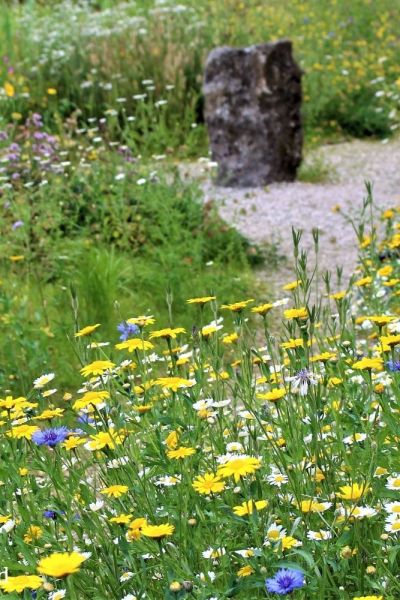
A garden wildflower meadow designed and installed by Joel Ashton and Hazelwood Landscapes. Photo copyright Joel Ashton.
How to get rid of floppy, green grass and have more wildflowers
Joel suggests two ways of weakening the lawn grasses in an established lawn if you don’t want to remove the turf.
The seasonal meadow
You could treat your meadow lawn as seasonal. ‘Lawn grasses grow most vigorously in spring and early summer,’ he says. ‘So you can mow them until early summer, then let the grass grow.
The lawn doesn’t grow so fast after mid-summer. It will give the late season wildflowers, such as oxeye daisies, a chance. But you would lose your spring meadow flowers – the bulbs, cowslips and primroses.’
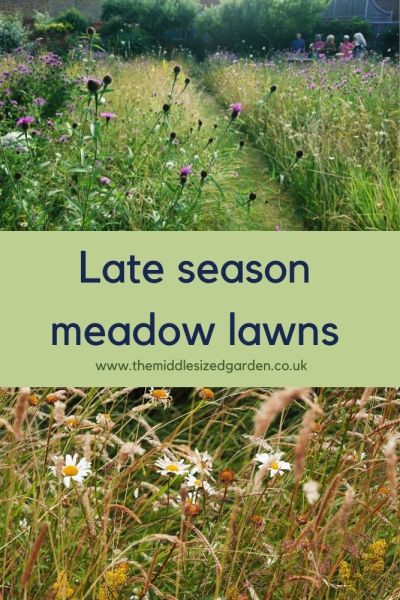
These are two meadow lawns, both photographed in July with later flowering meadow flowers.
Add yellow rattle
The other option is to mow really short in early autumn and then scarify the lawn thoroughly. Scarifying is using a rake to clear the lawn of dead grass, creeping roots and moss. It’ll thin the lawn grass out and give seeds the chance to grow.
You should then sow yellow rattle (Rhinanthus minor) to weaken the lawn grasses further. You can sow seed directly the following autumn. Or you can buy plug plants to plant between March and May.
After a year of growing yellow rattle in your meadow patch, the grasses will be less vigorous. You should then be able to sow wildflower seeds or plug plants in the years after that.
Depending on how much yellow rattle you plant, it may take a few years for it to work its way through your lawn and weaken all the grasses.
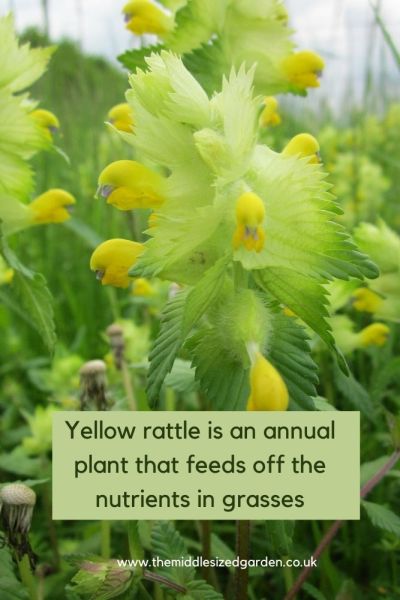
Once you’ve sown yellow rattle into your meadow lawn, it should spread, emerging in different places each year. It is an annual, which grows, flowers and dies in one year, dropping its seeds for next year’s plants.
Meadow lawn mistakes with weeding
We have an infestation of ground elder that I have battled to contain. Regular mowing kept it out of the lawn, but when we stopped mowing, the ground elder moved into the grass.
Joel advised me that I should continue weeding it out by hand. ‘I don’t recommend chemical solutions,’ he says.
But if you leave pervasive weeds in the lawn, they will take over. The wildflowers will be crowded out.
Which are wildflowers and which are weeds?
Many of the plants recommended for a perennial wildflower meadow are considered weeds in a garden context.
So you may have to re-think your approach to weeds and gardening in general. Some weeds will invade the meadow lawn, taking it over. Others have a place in it.
But our tolerance of weeds is changing. I’ve always had a lot of self-seeded plants, which also means a lot of weeds. See Self-seeded plants vs weeds!
Books such as Jack Wallington’s Wild About Weeds -Garden Design with Rebel Plants show how to work with weeds rather than battle against them. See our interview with Jack here.
Avoid planting ‘invasive’ weeds
And some plants are well behaved wildflowers when they’re at home. Exported to another country, they can become noxious, invasive weeds and can even be banned.
For example, Knapweed (Centaurea nigra) is considered native to the UK and parts of Europe. But in the US, Australia and several other countries, it is considered a dangerously invasive weed.
This is one reason why buying wildflower seed mixes can be one of the more dangerous meadow lawn mistakes. You should read the list of contents carefully in order to make sure that none of the plants included are invasive in your part of the world.
Should you plant native wildflowers in a meadow lawn?
The definition of ‘native plants’ varies, but they are certainly plants that have grown in an area for thousands of years. Local wildlife has evolved to depend on them for food and shelter.
If a new plant is introduced to a wild area, it may out-compete the native plants. And the wildlife that depended on them loses a source of food and shelter. Often they can’t adapt quickly enough to the new plants.
So Joel says that you should focus on native wildflowers for meadow lawns or other wild areas.
But also consider ‘nectar borders’
However, Hazelwood Landscapes also designs and installs ‘nectar borders’ in gardens. These are borders, such as herbaceous borders, which offer maximum nectar for pollinating insects.

Joel also designs and installs more traditional borders, like this stunning ‘nectar border’, packed with wildlife friendly plants. He believes that many non-native plants have huge benefits for pollinators when grown in a border. But he advises planting native wildflowers in meadow patches. Photo copyright Joel Ashton.
Some plants that have been introduced to the UK, such as salvias and verbena bonariensis, are hugely popular with our bees, butterflies, moths and other wildlife.
Some people feel that you should only grow native plants in any part of your garden. But in the UK, after extensive research, the RHS recommends a wide variety of both native and non-native plants in order to provide maximum resources for pollinators.
Does weeding and mowing a meadow lawn harm wildlife?
We didn’t want to dig our front lawn or remove turf because we didn’t want to harm the ground nesting bees. But that’s made me nervous of doing anything to it.
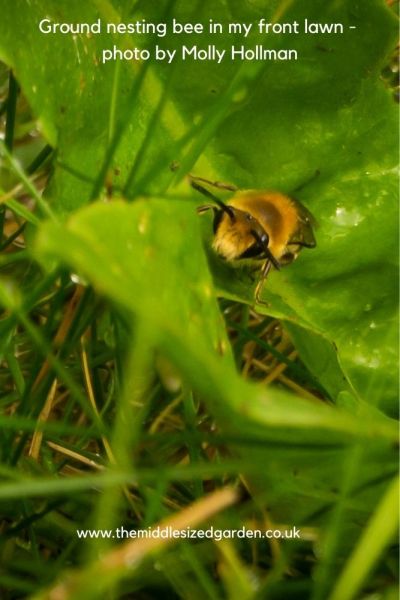
Photographer Molly Hollman took this amazing photo of one of the ground-nesting bees in our front garden. I love his little face.
There’s no doubt, however, that one of the biggest meadow lawn mistakes is to think that you can just leave the lawn to look after itself. I do need to both weed it and cut it, although the cutting is only once a year.
Joel says that all human activities and occupation impact wildlife. So when we dig a wildlife pond or create a meadow lawn, we may well be disturbing or disrupting wildlife. ‘You can’t make an omelette without breaking eggs.’
In the long term, however, more wildlife will benefit from the disruption, so you ‘have to accept some casualties.’
Note that scything a lawn or cutting it with shears takes longer than using a mower. That gives tiny mammals and frogs a chance to get out of the way. And Joel advocates leaving a few inches of grass, where the tiny ones, such as caterpillar larvae, can wait until spring.
More about Joel Ashton
You can contact Joel Ashton about designing and installing wildlife-friendly gardens and landscapes at Hazelwood Landscapes. They cover all aspects of gardening, including tree surgery, bird habitat creation and wildlife ponds. They also run wildlife gardening workshops and you can commission a bespoke workshop from them, too.
You can also follow Joel on Twitter or Instagram. He has appeared on Springwatch, Gardener’s World, Wild Animal Rescue, The Steph Show and other TV programmes. (For TV and writing, see joelashton.com)
And do check out his YouTube channel Wild Your Garden with Joel Ashton. It has excellent videos on how to make your garden more wildlife-friendly.
And if you’d like to see our full conversation about making a successful meadow lawn, see the video here.
And if you’d like a traditional lawn but not too much work….
If you’ve decided you’d rather stick with a traditional lawn, there are ways of making it less effort. Lawn grass, whether it is a meadow or a traditional lawn, provides habitat for wildlife and lawns absorb heat and carbon dioxide.
They are a huge asset to gardens and can be very environmentally friendly, provided you don’t use too many chemicals or water them in a drought. For more about choosing the right lawn for your lifestyle, see this interview with David Hedges Gower of the Lawn Association on Do You Really Need a Perfect Lawn?
Pin to remember mini meadow lawn mistakes
And do join us for a free weekly email with tips, ideas and inspiration for your garden.


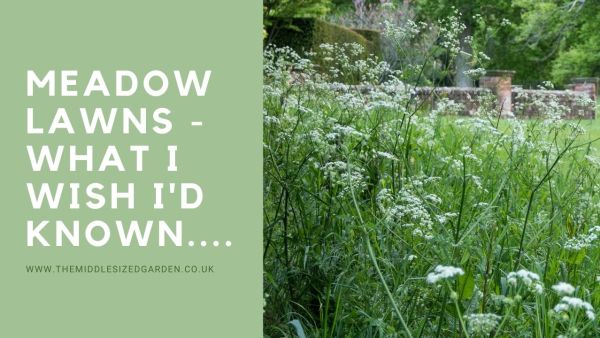























Thank for such a useful video. I bought low growing wildflower turf for my tiny front lawn but it was mostly clover. Seeds for part of it were not successful. I scarified and sowed local yellow rattle last autumn. Seems locally grown can be more successful. Was advised to wait until established before mowing. No mow May didn’t work for me in the south west so will play it by ear. Tried plugs,no go, fox and Cubs bought as 9 cms were much better. Learning to love dandelions as the bees do. Baby sparrows were fed there last year. Thrilled with one very small Ragged Robin though so will persevere!
It sounds lovely, however especially the baby sparrows. Hope this year works out for you.
A sunny spot is also key – very few meadow flowers tolerate shade.
Excellent point, thank you!